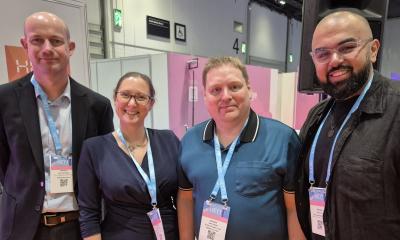We‘ll have highly personalised avatars
Petabytes of data on each patient will become the foundation of future diagnostics and therapy.

Genetics, imaging and environmental information – toxins, lifestyle – will deliver a precise picture of the individual, allowing for diagnostic precision and targeted treatments. At the recent Swiss eHealth Summit, Michael Reiter asked proteomics expert professor Denis Hochstrasser how physicians could put this
information tsunami to good use in the future.
Explaining the basic influencing factors for disease, Professor Denis Hochstrasser says there are two: ‘Genes and the environment, which includes toxics and microbes.’ To illustrate this, he adds, ‘When the American Indians hunted buffalo and ate mostly meat, they had no diabetes even though they had the genes for that. Today, with their orientation towards a USA lifestyle, they sit and watch TV, eat popcorn and drink soft drinks... and many of them have diabetes. That’s outside infl uence fostering genetic predisposition. In quite a few cases, it’s a combination of the three types of factors – a predisposition for tuberculosis is supported by genetic predisposition, too much alcohol consumption, which ruins the immune system and paves the way for the disease.’
How can determinants for therapy be identified?
‘We need to look into each case. Someone who is obese and has high blood pressure may be genetically predisposed; medication to reduce blood pressure is the suitable therapy. If losing weight could cut down blood pressure, the fi rst-line therapy would be to go for weight loss.’
Are there challenges for medicine from IT?
‘Today, we are swamped with medical information. Studies for some sample hospitals show that up to three percent of the data are not seen by the physician. The reason is not that physicians are too lazy to scrutinise that information but that the sheer volume of data in various formats out of the tsunami of information makes it impossible to look at everything. ‘When I do rounds with my young interns and residents, and we carry a portable computer with us, there are thousands of documents and images and Excel sheets as well as other fi les... there is no way you can look at them all. ‘There is a desperate need for an intelligent IT-driven tool that helps fi lter that information and display the relevant information for each patient right away. It should highlight, issue by issue, the patient’s abnormalities. Here’s a sample case: A 60-year-old male has a history of a myocardial infarction, he is diabetic, has a lipid disorder, a colon problem and a history of cancer in the family. The challenge is to present one by one and make sure you are not missing anything.’
What could a virtual patient contribute?
‘That virtual patient, the medical avatar could – in 3-D – highlight the issues and show all the relevant medical information. It could collect all the information generated when a patient sees his GP, has lab tests in a private lab, and during his stays at a hospital. The patient would own the avatar and have that information available anywhere, anytime, for his next appointment. ‘Nhumi, a start-up in Zurich, works on such a concept. It stands for Next generation HUMan Interface and works towards smart user interfaces as a next generation of analytical tools. Those tools are designed to provide a natural integration point where end users will extract key patterns easily and retrieve the desired information much faster.’
Where does modelling come in?
‘The idea is to try to model therapies and medication in a patient model, in an analogy to a fl ight simulator. This required modelling some of the most common diseases. In some ways it’s taking Guyton’s towards the future – that model from the 1970’s was geared towards high blood pressure, salt, and kidney function. Recently a full model of the microplasma genitalia was developed; as soon as, for example, a leucaemic cell is modelled, we can treat the model fi rst and fi nd out the right treatment for the patient.’
How can proteomics be put into clinical practice? ‘There’s a major project called ITFoM – IT Future of Medicine that aims at establishing the ICT workfl ows and structures to integrate the analytical and clinical data of a patient into an individualised model of the patient. Various groups are working on mathematical models, some on human genome sequencing, some on proteome analysis. We hope to be granted EU fi nancing as of late 2012. I’m the coordinator for Switzerland, and have a special role moderating between science and clinicians.’
What could be the effect on prevention?
‘Genes co-determine whether someone develops cancer of the breast or colon. As soon as the genome of an individual has been established, as well as any genetic risk, any need for further checks and preventive measures can be determined. Of course, any such decisions will be left to the individual, and data privacy needs to be ensured. Otherwise, preconditions might pre-empt insurance.’
What future role could the electronic medical record play?
‘The EMR is the foundation for the avatar. The avatar concatenates the EMR information and the model will help test therapeutic approaches. There would be standardisation of storing and of displaying in 3-D. We’ll need intelligence to compare genetic information with aspects from the environment, and display all that. Patients will own their EMR – that’s part of the challenge in the culture of care we’ll be looking at.’
What is the timeline and what might the impact be on the clinician- patient relationship?
‘Some aspects can start now whilst others will take more time. Cancer and orphan diseases will be the fi rst conditions to have their mechanisms fi gured out. The relationship between the physician and the patient will still remain at the core of care. Everything will be useless if there is no interaction and compassion to support diagnosis and therapy.’
PROFILE
Professor Denis Hochstrasser MD is Vice-Dean of the Faculty of Medicine, Chairman of the Department of Genetics and Laboratory Medicine, and he directs the Laboratory Medicine Ser vice at Geneva University and University Hospital, Geneva (HUG), Switzerland. Among the world’s leading proteomics scientists, he serves on the HPP Senior Scientifi c Advisory Board of HUPO, the Human Proteome Organisation Council.
07.11.2012











